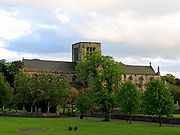Is a town and former Royal Burgh in East Lothian, Scotland. It is the main administrative, cultural and geographical centre for East Lothian, which was known officially as Haddingtonshire before 1921. It lies approximately 20 miles (32 km) east of Edinburgh. It was the first Royal Burgh, created sometime in the reign of David I (1124-1153), and at the time contained an Abbey and monastery.
Today Haddington is a small town with a population of less than 9,000, although at one time it was the fourth largest city in Scotland, after Aberdeen, Dundee and Edinburgh. At the centre of the town is the Town House, originally built in 1748 according to a plan by William Adam. When first built, it consisted of a council chamber, jail and sheriff court, to which assembly rooms were added in 1788, and a new clock in 1835. Nearby is the Corn Exchange (1854) and the County Courthouse (1833). Other notable sites include the Jane Welsh Carlyle House, and Mitchell's Close. |
Haddington is located predominantly on the north-east bank of the River Tyne, and was once famous for its mills. It developed into the fourth largest town in Scotland during the High Middle Ages, and latterly was at the centre of the mid-18th century Scottish Agricultural Revolution.
In 1641 an Act was passed by the Parliament of Scotland to encourage the production of fine cloth, and in 1645 an amendment went through stating that the masters and workers of manufactories would be exempt from military service. As a result of this, more factories were established; these included the New Mills. This factory suffered during the Civil War with the loss of its cloth to General Monk. A new charter was drawn up in May 1681, and major capital invested in new machinery, but the New Mills had mixed fortunes, inevitably affected by the lack of protectionism for Scottish manufactured cloth. The Scots Courant reported in 1712 that New Mills was to be 'rouped' (auctioned). The property was sold on 16 February 1713 and the machinery and plant on March 20. The lands of New Mills were purchased by Colonel Francis Charteris and he changed their name to Amisfield. |
Amisfield House was described in The Buildings of Scotland as "the most important building of the orthodox Palladian school in Scotland." John Henderson built the walled garden in 1783, and the castellated stable block in 1785. The park in front of the house, possibly landscaped by James Bowie, is today entirely ploughed. The house was demolished in 1928.
All that remains of Amisfield today are the summer house, walled garden, ice house, chapel, and gates.
Lennoxlove House, a historic 13th century house and estate, lies half a mile south of Haddington. Built by the Giffards of Yester, it was originally named Lethington. It was once home to the Maitland family, notably Sir Richard Maitland, and his son William Maitlin, Secretary of State to Mary Queen of Scots'. The Maitlands left Lennoxlove in the 17th century, and it is now the seat of the Duke of Hamilton and Brandon.
The world's earliest surviving records of a lodge of free gardeners come from Haddington, in 1676. |
St Mary's Collegiate Church |
|
|
|

The Parish Church of St Mary's is today part of the Church of Scotland, but includes an Episcopalian chapel, the Lauderdale Aisle, containing the mausoleum of the Earls of Lauderdale. It is the longest parish church in Scotland and is in regular use for worship and musical events. It is directly adjacent to the river Tyne, beside the 12th century Nungate bridge.
The present building (built with red sandstone from nearby Garvald) was started in 1375 (an earlier St Mary's Church having been destroyed by the English in 1356), and consecrated in 1410, despite building work not being finished until 1487. The church was partially destroyed during the 1548-49 Siege of Haddington that followed the Rough Wooing of Henry VIII, and on the advice of John Knox, it was restored "frae the tower to the West door". Thus the nave became the church and the choir and transepts were left ruined until the whole church was restored in the 1970s. The Lammermuir pipe organ was built in 1990.
A set of eight bells hung for full change ringing was installed for the Millennium. |

 ©peh
©peh